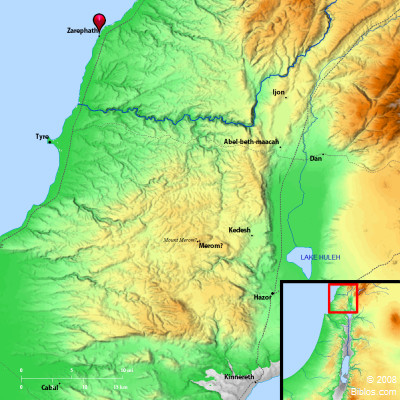Atlas  Zarephath and surrounding region Maps Created using Biblemapper 3.0 Additional data from OpenBible.info Occurrences 1 Kings 17:9 "Arise, go to Zarephath, which belongs to Sidon, and stay there. Behold, I have commanded a widow there to sustain you."1 Kings 17:10 So he arose and went to Zarephath; and when he came to the gate of the city, behold, a widow was there gathering sticks: and he called to her, and said, "Please get me a little water in a vessel, that I may drink." Obadiah 1:20 The captives of this army of the children of Israel, who are among the Canaanites, will possess even to Zarephath; and the captives of Jerusalem, who are in Sepharad, will possess the cities of the Negev. Luke 4:26 Elijah was sent to none of them, except to Zarephath, in the land of Sidon, to a woman who was a widow. Encyclopedia ZAREPHATHzar'-e-fath (tsarephath; Sarepta): The Sidonian town in which Elijah was entertained by a widow after he left the brook Cherith (1 Kings 17:9). Obadiah refers to it as a Canaanite (probably meaning Phoenicia) town (Obadiah 1:20). It appears in the Greek form Sarepta in Luke 4:26 (the King James Version), and is said to be in the land of Sidon. Josephus (Ant., VIII, xiii, 2) says it was not "far from Sidon and Tyre, for it lay between them." Eusebius, Onomasticon (s.v. "Sarefta"), places it on the public road, i.e. the road along the seashore. It can be no other than the modern Sarafend, about 13 miles North of Tyre, on the spur of the mountain which divides the plain of Tyre from that of Sidon. ZAR'EPHATH, same as Sarepta of the N.T., a town of Phenicia on the seashore, 7 ms. s. of Sidon. Only ruius are found and no inhabitants, now called Surafend. Strong's Greek G4558: SareptaSarepta, a city near Sidon |



